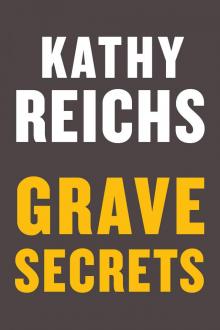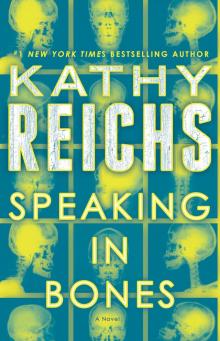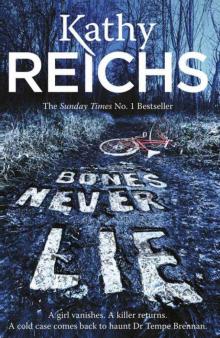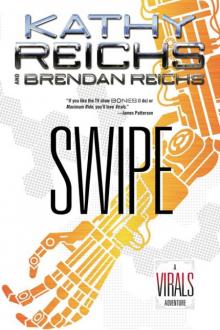- Home
- Kathy Reichs
Deadly Decisions
Deadly Decisions Read online
“Fans of TV’s CSI: Crime Scene Investigation should be in heaven” (People) stepping into the world of forensic anthropologist Dr. Temperance Brennan, star of Kathy Reichs’ electrifyingly authentic bestsellers.
When innocent blood is spilled, she deciphers the shattering truths it holds.
Nine-year-old Emily Anne Toussaint is fatally shot on a Montreal street. A North Carolina teenager disappears from her home, and parts of her skeleton are found hundreds of miles away. The shocking deaths propel Tempe Brennan from north to south, and deep into a shattering investigation inside the bizarre culture of outlaw motorcycle gangs—where one misstep could bring disaster for herself or someone she loves.
“REMINISCENT OF PATRICIA CORNWELL AT THE TOP OF HER GAME. . . . Moves along like a Harley-Davidson leading the pack.”
—The San Francisco Examiner
“THE FORENSIC DETAILS ARE FASCINATING.”
—The Orlando Sentinel (FL)
“A HIGH-OCTANE FORENSIC THRILLER.”
—People
Includes an excerpt from Bones to Ashes—coming soon in hardcover from Scribner!
Register online at www.SimonandSchuster.com for more information on this and other great books.
ABOUT THE AUTHOR
KATHY REICHS, like her fictional creation Temperance Brennan, is a board-certified forensic anthropologist for the Laboratoire de Sciences Judiciaires et de Médecine Légale for the province of Quebec, a position she also held at the Office of the Chief Medical Examiner, State of North Carolina. She is Vice President of the American Academy of Forensic Sciences and serves on the National Police Services Advisory Council in Canada. A professor of anthropology at the University of North Carolina at Charlotte, Dr. Reichs received her Ph.D. at Northwestern University. She now divides her time between Charlotte and Montreal. Her debut novel, Déjà Dead, brought her fame when it became a New York Times bestseller, a #1 international bestseller, and winner of the 1997 Ellis Award for Best First Novel. Bones to Ashes, her tenth Temperance Brennan novel, is forthcoming in hardcover from Scribner.
Her website is www.kathyreichs.com.
ALSO BY KATHY REICHS
DÉJÀ DEAD
DEATH DU JOUR
Thank you for purchasing this Scribner eBook.
Sign up for our newsletter and receive special offers, access to bonus content, and info on the latest new releases and other great eBooks from Scribner and Simon & Schuster.
or visit us online to sign up at
eBookNews.SimonandSchuster.com
SCRIBNER
1230 Avenue of the Americas
New York, NY 10020
www.SimonandSchuster.com
Copyright © 2000 by Temperance Brennan, L.P.
All rights reserved, including the right of reproduction in whole or in part in any form.
SCRIBNER and design are trademarks of Macmillan Library Reference USA, Inc., used under license by Simon & Schuster, the publisher of this work.
DESIGNED BY ERICH HOBBING
Text set in Stempel Garamond
Library of Congress Cataloging-in-Publication Data
Reichs, Kathleen J.
Deadly décisions/Kathy Reichs.
p. cm.
1. Brennan, Temperance (Fictitious character)—Fiction. 2. Women detectives—Québec
(Province)—Montréal—Fiction. 3. Medical examiners (Law)—Fiction.
4. Forensic anthropology—Fiction. 5. Montréal (Québec)—Fiction. I. Title.
PS3568.E476345 D35 2000
813'.54—dc21
00–022220
ISBN 0-684-85971-8
ISBN-13: 978-0-7432-1077-5 (eBook)
Dedicated with love to the Carolina Beach Bunch
Contents
Acknowledgments
Chapter 1
Chapter 2
Chapter 3
Chapter 4
Chapter 5
Chapter 6
Chapter 7
Chapter 8
Chapter 9
Chapter 10
Chapter 11
Chapter 12
Chapter 13
Chapter 14
Chapter 15
Chapter 16
Chapter 17
Chapter 18
Chapter 19
Chapter 20
Chapter 21
Chapter 22
Chapter 23
Chapter 24
Chapter 25
Chapter 26
Chapter 27
Chapter 28
Chapter 29
Chapter 30
Chapter 31
Chapter 32
Chapter 33
Chapter 34
Chapter 35
Chapter 36
Chapter 37
Chapter 38
Chapter 39
Chapter 40
About the Author
The characters and events in this book are fictional and created out of the imagination of the author. The setting is in Montreal, Canada; North Carolina; and other locations. Certain real locations and institutions are mentioned, but the characters and events depicted are entirely fictional.
ACKNOWLEDGMENTS
Many people helped me in writing Deadly Décisions. Particularly patient were my colleagues in forensic science and law enforcement. I owe heartfelt thanks to Sergeant Guy Ouelette, Division of Organized Crime Unit, Sûreté du Québec, and to Captain Steven Chabot, Sergent Yves Trudel, Caporal Jacques Morin, and Constable Jean Ratté at Opération Carcajou in Montreal.
Among the Communauté Urbaine de Montréal Police, Lieutenant-détective Jean-François Martin, Division des Crimes Majeurs; Sergent-détective Johanne Bérubé, Division Agressions Sexuelles; and Commandant André Bouchard, Moralité, Alcool, et Stupéfiant, Centre Opérational Sud, patiently answered my questions and explained the functioning of police units. Special thanks must go to Sergent-détective Stephen Rudman, Superviseur, Analyse et Liaison, Centre Opérational Sud, who answered many questions, provided maps, and took me through the jail.
Of my colleagues at the Laboratoire de Sciences Judiciaires et de Médecine Légale I must thank Dr. Claude Pothel for comments on pathology, and François Julien, Section de Biologie, for his demonstration of blood-spatter patterning. Pat Laturnus, Bloodstain Pattern Analyst at the Canadian Police College in Ottawa, also helped with this expertise, and provided photos for cover design.
In North Carolina, I would like to thank Captain Terry Sult of the Charlotte-Mecklenburg Police Department Intelligence Unit; Roger Thompson, Director of the Charlotte-Mecklenburg Police Department Crime Laboratory; Pam Stephenson, Senior Analyst, Intelligence and Technical Services, North Carolina State Bureau of Investigation; Gretchen C. F. Shappert, United States Attorney General’s Office; and Dr. Norman J. Kramer, Mecklenburg Medical Group.
Others who gave of their time and knowledge include Dr. G. Clark Davenport, Geophysicist with NecroSearch International; Dr. Wayne Lord, National Center for the Analysis of Violent Crime, FBI Academy, Quantico, Virginia; and Victor Svoboda, Director of Communication for the Montreal Neurological Institute and the Montreal Neurological Hospital. Dr. David Taub was my Harley-Davidson guru.
I am indebted to Yves St. Marie, Directeur, Laboratoire de Sciences Judiciaires et de Médecine Légale; Dr. André Lauzon, Responsable, Laboratoire de Médecine Légale; and to Dr. James Woodward, Chancellor of the University of North Carolina at Charlotte for their continued support.
Special thanks go to Paul Reichs for his valuable comments on the manuscript.
As always I want to thank my extraordinary editors, Susanne Kirk at Scribner, and Lynne Drew at Random House, and my slam-dunk agent, Jennifer Rudolph Walsh.
Though I benefited greatly from the advice of experts,
any errors in Deadly Décisions are strictly of my making.
DEADLY
DÉCISIONS
HER NAME WAS EMILY ANNE. SHE WAS NINE YEARS OLD, WITH black ringlets, long lashes, and caramel-colored skin. Her ears were pierced with tiny gold loops. Her forehead was pierced by two slugs from a Cobra 9-mm semiautomatic.
• • •
It was a Saturday, and I was working by special request of my boss, Pierre LaManche. I’d been at the lab for four hours, sorting badly mangled tissue, when the door to the large autopsy room opened and Sergeant-Detective Luc Claudel came striding in.
Claudel and I had worked together in the past, and though he’d come to tolerate, perhaps even appreciate me, one would not infer that from his brusque manner.
“Where’s LaManche?” he demanded, glancing at the gurney in front of me, then quickly away.
I said nothing. When Claudel was in one of his moods, I ignored him.
“Has Dr. LaManche arrived?” The detective avoided looking at my greasy gloves.
“It’s Saturday, Monsieur Claudel. He doesn’t wo—”
At that moment Michel Charbonneau stuck his head into the room. Through the opening I could hear the whir and clank of the electric door at the back of the building.
“Le cadavre est arrivé,” Charbonneau told his partner.
What cadaver? Why were two homicide detectives at the morgue on a Saturday afternoon?
Charbonneau greeted me in English. He was a large man, with spiky hair that resembled a hedgehog’s.
“Hey, Doc.”
“What’s going on?” I asked, pulling off my gloves and lowering my mask.
Claudel answered, his face tense, his eyes cheerless in the harsh fluorescent light.
“Dr. LaManche will be here shortly. He can explain.”
Already sweat glistened on his forehead, and his mouth was compressed into a thin, tight line. Claudel detested autopsies and avoided the morgue as much as possible. Without another word he pulled the door wide and brushed past his partner. Charbonneau watched him walk down the corridor, then turned back to me.
“This is hard for him. He has kids.”
“Kids?” I felt something cold in my chest.
“The Heathens struck this morning. Ever hear of Richard Marcotte?”
The name was vaguely familiar.
“Maybe you know him as Araignée. Spider.” He curled his fingers like a child doing the waterspout rhyme. “Great guy. And an elected official in the outlaw biker set. Spider is the Vipers sergeant at arms, but he had a real bad day today. When he set out for the gym around eight this morning the Heathens blasted him in a drive-by while his ole lady dove for cover in a lilac bush.”
Charbonneau ran a hand backward through his hair, swallowed.
I waited.
“In the process they also killed a child.”
“Oh, God.” My fingers tightened around the gloves.
“A little girl. They took her to the Montréal Children’s Hospital, but she didn’t make it. They’re bringing her here now. Marcotte was DOA. He’s out back.”
“LaManche is coming in?”
Charbonneau nodded.
The five pathologists at the lab take turns being on call. Rarely does it happen, but if an off-hours autopsy or visit to a death scene is deemed necessary, someone is always available. Today that was LaManche.
A child. I could feel the familiar surge of emotions and needed to get away.
My watch said twelve-forty. I tore off my plastic apron, balled it together with the mask and latex gloves, and threw everything into a biological waste container. Then I washed my hands and rode the elevator to the twelfth floor.
I don’t know how long I sat in my office, staring at the St. Lawrence and ignoring my carton of yogurt. At one point I thought I heard LaManche’s door, then the swish of the glass security doors that separate portions of our wing.
Being a forensic anthropologist, I’ve developed some immunity to violent death. Since the medical examiner turns to me to derive information from the bones of the mutilated, burned, or decomposed, I’ve seen the worst. My workplaces are the morgue and autopsy room, so I know how a corpse looks and smells, how it feels when handled or cut with a scalpel. I’m accustomed to bloody clothing drying on racks, to the sound of a Stryker saw cutting through bone, to the sight of organs floating in numbered specimen jars.
But I have always been unsettled by the sight of dead children. The shaken baby, the battered toddler, the emaciated child of religious zealots, the preteen victim of a violent pedophile. The violation of young innocents has never failed to agitate and distress me.
Not long ago I had worked a case involving infants, twin boys killed and mutilated. It had been one of the most difficult encounters of my career, and I didn’t want to reboard that emotional merry-go-round.
Then again that case had been a source of satisfaction. When the fanatic responsible was locked up and could order no more executions, I felt a genuine sense of having accomplished something good.
I peeled back the cover and stirred the yogurt.
Images of those babies hovered in my mind. I remembered my feelings in the morgue that day, the flashbacks to my infant daughter.
Dear God, why such insanity? The mutilated men I had left downstairs had also died as a result of the current biker war.
Don’t get despondent, Brennan. Get angry. Get coldly, resolutely angry. Then apply your science to help nail the bastards.
“Yep,” I agreed with myself aloud.
I finished the yogurt, drained my drink, and headed downstairs.
• • •
Charbonneau was in the anteroom of one of the small autopsy suites, flipping pages in a spiral notebook. His large frame overflowed a vinyl chair opposite the desk. Claudel was nowhere to be seen.
“What’s her name?” I asked.
“Emily Anne Toussaint. She was on her way to dance class.”
“Where?”
“Verdun.” He tipped his head toward the adjoining room. “LaManche has begun the post.”
I slipped past the detective into the autopsy room.
A photographer was taking pictures while the pathologist made notes and shot Polaroid backups.
I watched LaManche grasp a camera by its side handles, then raise and lower it above the body. As the lens moved in and out of focus a small dot blurred then condensed over one of the wounds in the child’s forehead. When the perimeter of the dot grew sharp, LaManche depressed the shutter release. A white square slid out and he pulled it free and added it to a collection on the side counter.
Emily Anne’s body bore evidence of the intensive effort to save her life. Her head was partly bandaged, but I could see a clear tube protruding from her scalp, inserted to monitor intracranial pressure. An endotracheal tube ran down her throat and into her trachea and esophagus, placed in order to oxygenate the lungs and to block regurgitation from the stomach. Catheters for IV infusion remained in her subclavian, inguinal, and femoral vessels, and the circular white patches for EKG electrodes were still pasted to her chest.
Such a frantic intervention, almost like an assault. I closed my eyes and felt tears burn the backs of my lids.
I dragged my eyes back to the small body. Emily Anne wore nothing but a plastic hospital bracelet. Next to her lay a pale green hospital gown, bundled clothing, a pink backpack, and a pair of high-top red sneakers.
The harsh fluorescent light. The shining steel and tile. The cold, sterile surgical instruments. A little girl did not belong here.
When I looked up, LaManche’s sad eyes met mine. Though neither of us made reference to what lay on the stainless steel, I knew his thoughts. Another child. Another autopsy in this same room.
Putting a choke hold on my emotions, I described the progress I was making with my own cases, reassembling the corpses of two bikers who’d been blown apart by their own folly, and asked when antemortem medical records would be available. LaManche told me that the file
s had been requested and should arrive on Monday.
I thanked him and went to resume my own grim task. As I sorted tissue, I remembered my previous day’s conversation with LaManche, and wished I were still in the Virginia woods. Was it only yesterday LaManche had called me there? Emily Anne was alive then.
So much can change in twenty-four hours.
THE DAY BEFORE I HAD BEEN IN QUANTICO TEACHING A BODY recovery workshop at the FBI Academy. My team of evidence recovery technicians was unearthing and mapping its skeleton when I looked up to see a special agent approaching through the trees. He reported that a Dr. LaManche urgently wished to speak to me. Feeling uneasy, I left my team and started out of the woods.
As I threaded my way toward the road, I thought about LaManche and the news his call might bring. I began consulting for the Laboratoire de Sciences Judiciaires et de Médecine Légale after going to Montreal in the early nineties as part of a faculty exchange between McGill and my home university in Charlotte. Knowing I was certified by the American Board of Forensic Anthropology, LaManche had been curious as to whether I could be of any use to him.
Quebec Province had a centralized coroner system, with sophisticated crime and medico-legal labs, but no board-certified forensic anthropologist. Then, as now, I served as consultant to the Office of the Chief Medical Examiner in North Carolina, and LaManche wanted me for the LSJML. The ministry funded an anthropology lab, and I enrolled in an immersion course in French. For more than a decade now, the skeletonized, decomposed, mummified, burned, or mutilated cadavers of Quebec Province have come to me for analysis and identification. When a conventional autopsy is of no use, I tease what I can from the bones.
Rarely had LaManche left me a message marked urgent. When he had, it had never been good.
Within minutes I crossed to a van parked on the side of a gravel road. I released my hair and ran my fingers backward across my scalp.
No ticks.
After reclipping the barrette, I dug my pack from the back of the van and fished out my cell phone. The tiny screen told me I had missed three calls. I punched up the list of numbers. All three had come from the lab.

 Two Nights
Two Nights The Bone Collection: Four Novellas
The Bone Collection: Four Novellas Fatal Voyage
Fatal Voyage 206 Bones
206 Bones Bones to Ashes
Bones to Ashes Terminal
Terminal Monday Mourning
Monday Mourning Flash and Bones
Flash and Bones Cross Bones
Cross Bones Devil Bones
Devil Bones Break No Bones
Break No Bones Swamp Bones
Swamp Bones Déjà Dead
Déjà Dead Shock
Shock Spider Bones
Spider Bones Death Du Jour
Death Du Jour Grave Secrets
Grave Secrets Trace Evidence: A Virals Short Story Collection
Trace Evidence: A Virals Short Story Collection Bones on Ice
Bones on Ice The Bone Code
The Bone Code Bones in Her Pocket
Bones in Her Pocket Seizure:
Seizure: Speaking in Bones
Speaking in Bones Deadly Decisions
Deadly Decisions Spike
Spike Bones Never Lie
Bones Never Lie Bones of the Lost
Bones of the Lost Virals 03.5 - Swipe
Virals 03.5 - Swipe Exposure
Exposure A Conspiracy of Bones
A Conspiracy of Bones Shift (tory brennan)
Shift (tory brennan) Bones of the Lost: A Temperance Brennan Novel tb-16
Bones of the Lost: A Temperance Brennan Novel tb-16 Virals tb-1
Virals tb-1 Bones Are Forever tb-15
Bones Are Forever tb-15 Code tb-3
Code tb-3 Seizure tb-2
Seizure tb-2 Deadly Descisions
Deadly Descisions Spider Bones: A Novel
Spider Bones: A Novel